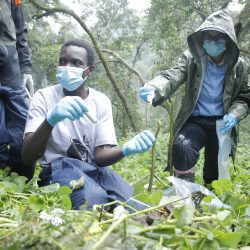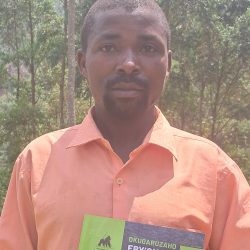From Virunga (Central Africa) to Ometepe Island (Central America), Part 1
Blog | 5/12/11
Eugène Rutagarama here, Director of the International Gorilla Conservation Programme. And the first thing I should do is explain where ‘here’ is. I am writing these line sitting at the balcony of Punta Theonoste, a hotel located at the beach of the Pacific Ocean where the sound of ocean waves is mixing with the soft music of Youssou N’door, the Senegalese music star.
After visiting the Ometepe project run by FFI, I am reminded of the old days of the Mountain Gorilla Project (MGP) and the beginning of the International Gorilla Conservation Programme (IGCP). The incredible passion of Salvadora, the Ometepe Project Manager reminded me those I saw into the eyes Annette Lanjouw and Katie Frohardt when I joined this team in 1997. Running an under-funded programme, you could see though how these women were (maybe naïvely) thinking of “moving mountains” to ensure that the status of mountain gorilla conservation changes at the best. But together with the people of the African great lakes, today mountain gorillas are thriving despite some recurrent threats. And I foresee the same for the people, primates and biodiversity of this island.
The Ometepe island project has all ingredients to bring tremendous change into the life of the people of this island and to maintain the rich biodiversity of this island. Communities I met grouped into cooperatives have the right attitude and the good will to contribute to this evolution and the team led by the capable Salvadora will certainly will certainly make it happen. The direction they are heading to is clear; financial means to back them will be found. Salvadora and her team have already won their first battle, making the Ometepe island a UNESCO Biosphere.
Invited by Fauna and Flora International (FFI) for an exchange of experience with their team of Nicaragua in Central America, I landed into Managua , the capital of Nicaragua after 40 hours of flight. Together with the African Wildlife Foundation, AWF, World Wide Fund for Nature, WWF, FFI is a coalition of the International Gorilla Conservation Programme (IGCP), a programme I joined in 1997.
Flying over Nicaragua from Miami in the USA, I could see scenic views formed here and there by green hills comparable of those of Rwanda, my country. The quick speed of processing my entry visa impressed me. The FFI country representative, Mr José Ortega had probably cleared the path; we had no time to waste. We boarded into project cars driven by José Ortega and Salvadora, straight to the first National Park where we watched the smoke of an active Volcano.Then José led us to Granada, an old town built in the 16th century by Spanish, a major town of transit for ship during this period when the Panama channel linking the Pacific and the Atlantic Ocean was not yet built. In the evening, we watched a very colorful ceremony of “Maria Virgin” gathering almost each resident of this small town.
The following day, the team drove us from the main land to the Ometepe Island through a very well organized ferry. Salvadora took the lead and guided us to 4 sites where she is building the capacity of cooperatives aiming to generate alternative livelihood to residents in return to them protecting a big chunk of forest serving as primates’ corridors. Having strategically identified a market for tomatoes, she has championed this crop by providing improved seed variety and small loans to farmers who are using organic fertilizers. The harvest is spectacular and one of the beneficiaries, Mr Nestor was proud of sharing his candid stories of how he started cultivating tomatoes just to access to easy loan but he found himself harvesting more cash crop than he had done in his entire life. Nestor is a joyful man making jokes at any opportunity. When I was introduced to him as a “gorilla manager”, he cautioned his community’s mates in the following words: “watch out, this gorilla man may take all of us to join them in the jungle of his gorillas because we look like them”! In the end of the visit, his young daughters hugged me warmly and offered me what they had in abundance, tomatoes.
After a night at the TOTOCO lodge, a lodge run in the integral meaning of eco-lodge, we waked up to follow Salvadora in climbing the Maderas volcano. This was a unique experience. An ecologist with a passion for birds, Salvadora was probably in her best mood. At every 50 meters, she would stop us to watch an endemic or special bird. In addition, Mr. Gonzales couldn’t miss any opportunity to show us a good tree with both the Spanish and scientific name. All the way, we were ourselves under the keen watch of howler monkeys who will be interrupting our discussion on birds with their big noises as to remind that the forest inhabitants are more diversified than our interest seemed to. During the climb, in addition to numerous birds species and howler monkeys we saw during the day, I was impressed by the way local community utilizes without much harm the space of this forest for different purposes including coffee plantation and banana plantain. At the end of the visit to the forest, we had the surprise of meeting a land turtle before heading to the wonderful project aiming to protect marine turtles. But this is the story for the next post.
On the way back, during the long drive shifting to the Pacific Ocean coast, I spent time discussing with Salvadora her project. I was impressed by the project and the boldness of her initiatives. At the end of the day, when I could sense her fatigue of the long drive and the long day of English (her first language is Spanish), I tried to divert to a light topic by asking her if she was planning to do further studies to enhance her career growth and opportunity. In a lyric but more serious voice than ever, she said: “Eugene, you know, I have started doing a PhD from the last 2 years. But due to some circumstances coupled to the load of work, I have interrupted my PhD. My PhD for the next years will be how much meal I will put on the plates of the people of Ometepe Island and how the forest of the Ometepe Island will look like”. I couldn’t have any comment on these inspiring words.




